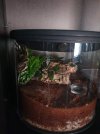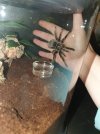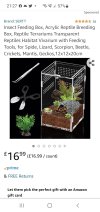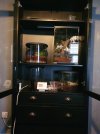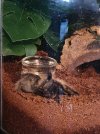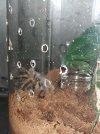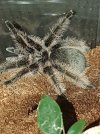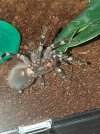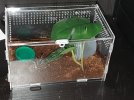Hi, apologies inadvance but this is a long post. (TLDR why have I lost 2 Ts in moult?)
I'm also aware I may get slated for some of my actions, but they were done with the best of intentions and I'm hoping to get some helpful advice rather than a telling off - trust me I doubt I could feel worse than I already do about it.
In January I got my first Ts: a juvenile B Smithii (5cm) and a C Versicolor (5 cm). Both were kept in cylindrical tarantula tanks which I purchased from the shop. The versicolor worried me as she didn't eat for a month, but then succesfully moulted. The smithii ate well from the start but then died in what appeared to be an upright moult approx 1 month ago (I posted on here at the time). Both had substrate also recommended by the shop and a waterbowl each which I checked and filled regularly.
When the smithii died I was convinced I'd done something wrong, but was advised that sometimes these things happen, so I took the plunge and bought an albopilosum (approx 12cm) and a Brazilian White Knee (5cm).
I had issues with the tank for the versicolor (also mentioned on here previously), so I bought a new tank with front opening doors so I could top up her waterbowl, remove unwanted food, monitor how damp the substrate was etc without damaging her web or having to leave my bare arm within inches of where she was lurking. I glued 2 water bowls to the cork bark and put in the plastic plants from her previous setup as she liked to chill in the orchid flowers (these were thoroughly washed before I used them). After I put her in the new set up she didn't want to eat again, even if I offered her meal worms on the edge of her web, but she had a good sized abdomen so I left it for a week and just kept an eye on her waterbowls. The following week she still didn't want food but still looked well fed, so again I left her to it thinking she may be due another moult -I was right, she was. I checked on her one evening about 13 days ago and saw that her carapace and abdomen had moulted and that she was moulting into adult colouration. The following morning she was still in the same boat, legs and underneath her body still in the old skin. I gave the tank a quick spray (avoiding spraying her) and monitored her throughout the day, but she wasn't getting any further and I was worrying about the old shell hardening. I called the vets, but no surprise they don't do Ts, so I took to the internet and found several posts and Youtube vids on rescuing stuck moults. In the end, after 48 hours from start of moult, I took the plunge and took her out and painted the old skin gently with a wet soft paintbrush to try and soften it further I did this every couple of hours for another 24 hours. When that failed too and she could only move her fangs I very carefully cut away the old skin. I managed to remove underneath and around her stomach ok, if anything she seemed relieved (kind of like taking a too tight bra off after a long day), and she started wriggling a bit more and her body literally seemed to expand, so I put her in an icu (tupperware tub lined with tissue and with air holes, a quick mist before she went in and a small waterbowl in the corner).
I got up every hour to check on her but by 4am there was still no difference and above her legs, she was starting to swell so one by one I very carefully cut away the old skin from her legs using a magnifying glass with built in light, tiny nail scissors and pointy tweezers.
I would work on her for an hour, dampen off the legs which were still encased and then leave her to recuperate for another hour before carrying on.
In total I worked on her for 48 hours. 4 legs refilled quite quickly and had some movement, 1 leg was withered to nothing and didn't refill, so I amputated it at the 1st joint and used vaseline on the cut as I know spiders cannot clot. The other 3 legs filled but seemed unresponsive. In the end all that was left in the old skin were her pedipalps but I had no idea how to remove the skin from them. I checked her and there was no sign of bleeding but I knew she was very weak so I decided to leave her for 4 hours to recuperate.
When I went back to her again to see what I could do with the pedipalps she was no longer responsive. I knew the chances of saving that small a spider stuck in such a moult were almost zero, but I had to at least try. I was still devastated though because after clearing her stomach area she had really started putting in more effort and I was really hoping she would pull through.
The problem I have now is I'm terrified of losing my other 2 in moults. Everything they do I'm analysing - my albo is sitting on the side of the tank (pictures below), does that mean she doesn't like the substrate? It isn't wet, it came out of the bag damp when I set it up 3 or 4 weeks ago, but I've read I should let it dry out before slightly overwatering the water bowl. I change the water twice a week using dechlorinated water (1 drop per 500ml) using a dechlorinator I also bought from the shop. Our water here is really hard (GH 16, pH 8.2), could this have an impact on the moulting process too?
Everytime I change the water my albo drops a bit of substrate in it and I have no idea why! She has also made a little bit of a mat on the ground with her silk - is this a sign of an upcoming moult?
She is still eating well and still doing her 'happy dance' each time she gets her food but I'm worrying constantly. The white knee also likes to sit on the side of the tank, just above the substrate - again she eats well but I'm worrying about her too
I've put up pics of my 2 remaining spiders and the set up I had the versicolor in (sorry about the quality). It has taken me a week to pluck up courage to write this post and to be able to do so without sobbing (too much) over my phone.
I feel ashamed and responsible for the loss of 2 lovely Ts, but I really want to make sure it doesn't happen again. Any constructive advice would therefore be gratefully appreciated.
I'm also aware I may get slated for some of my actions, but they were done with the best of intentions and I'm hoping to get some helpful advice rather than a telling off - trust me I doubt I could feel worse than I already do about it.
In January I got my first Ts: a juvenile B Smithii (5cm) and a C Versicolor (5 cm). Both were kept in cylindrical tarantula tanks which I purchased from the shop. The versicolor worried me as she didn't eat for a month, but then succesfully moulted. The smithii ate well from the start but then died in what appeared to be an upright moult approx 1 month ago (I posted on here at the time). Both had substrate also recommended by the shop and a waterbowl each which I checked and filled regularly.
When the smithii died I was convinced I'd done something wrong, but was advised that sometimes these things happen, so I took the plunge and bought an albopilosum (approx 12cm) and a Brazilian White Knee (5cm).
I had issues with the tank for the versicolor (also mentioned on here previously), so I bought a new tank with front opening doors so I could top up her waterbowl, remove unwanted food, monitor how damp the substrate was etc without damaging her web or having to leave my bare arm within inches of where she was lurking. I glued 2 water bowls to the cork bark and put in the plastic plants from her previous setup as she liked to chill in the orchid flowers (these were thoroughly washed before I used them). After I put her in the new set up she didn't want to eat again, even if I offered her meal worms on the edge of her web, but she had a good sized abdomen so I left it for a week and just kept an eye on her waterbowls. The following week she still didn't want food but still looked well fed, so again I left her to it thinking she may be due another moult -I was right, she was. I checked on her one evening about 13 days ago and saw that her carapace and abdomen had moulted and that she was moulting into adult colouration. The following morning she was still in the same boat, legs and underneath her body still in the old skin. I gave the tank a quick spray (avoiding spraying her) and monitored her throughout the day, but she wasn't getting any further and I was worrying about the old shell hardening. I called the vets, but no surprise they don't do Ts, so I took to the internet and found several posts and Youtube vids on rescuing stuck moults. In the end, after 48 hours from start of moult, I took the plunge and took her out and painted the old skin gently with a wet soft paintbrush to try and soften it further I did this every couple of hours for another 24 hours. When that failed too and she could only move her fangs I very carefully cut away the old skin. I managed to remove underneath and around her stomach ok, if anything she seemed relieved (kind of like taking a too tight bra off after a long day), and she started wriggling a bit more and her body literally seemed to expand, so I put her in an icu (tupperware tub lined with tissue and with air holes, a quick mist before she went in and a small waterbowl in the corner).
I got up every hour to check on her but by 4am there was still no difference and above her legs, she was starting to swell so one by one I very carefully cut away the old skin from her legs using a magnifying glass with built in light, tiny nail scissors and pointy tweezers.
I would work on her for an hour, dampen off the legs which were still encased and then leave her to recuperate for another hour before carrying on.
In total I worked on her for 48 hours. 4 legs refilled quite quickly and had some movement, 1 leg was withered to nothing and didn't refill, so I amputated it at the 1st joint and used vaseline on the cut as I know spiders cannot clot. The other 3 legs filled but seemed unresponsive. In the end all that was left in the old skin were her pedipalps but I had no idea how to remove the skin from them. I checked her and there was no sign of bleeding but I knew she was very weak so I decided to leave her for 4 hours to recuperate.
When I went back to her again to see what I could do with the pedipalps she was no longer responsive. I knew the chances of saving that small a spider stuck in such a moult were almost zero, but I had to at least try. I was still devastated though because after clearing her stomach area she had really started putting in more effort and I was really hoping she would pull through.
The problem I have now is I'm terrified of losing my other 2 in moults. Everything they do I'm analysing - my albo is sitting on the side of the tank (pictures below), does that mean she doesn't like the substrate? It isn't wet, it came out of the bag damp when I set it up 3 or 4 weeks ago, but I've read I should let it dry out before slightly overwatering the water bowl. I change the water twice a week using dechlorinated water (1 drop per 500ml) using a dechlorinator I also bought from the shop. Our water here is really hard (GH 16, pH 8.2), could this have an impact on the moulting process too?
Everytime I change the water my albo drops a bit of substrate in it and I have no idea why! She has also made a little bit of a mat on the ground with her silk - is this a sign of an upcoming moult?
She is still eating well and still doing her 'happy dance' each time she gets her food but I'm worrying constantly. The white knee also likes to sit on the side of the tank, just above the substrate - again she eats well but I'm worrying about her too
I've put up pics of my 2 remaining spiders and the set up I had the versicolor in (sorry about the quality). It has taken me a week to pluck up courage to write this post and to be able to do so without sobbing (too much) over my phone.
I feel ashamed and responsible for the loss of 2 lovely Ts, but I really want to make sure it doesn't happen again. Any constructive advice would therefore be gratefully appreciated.
